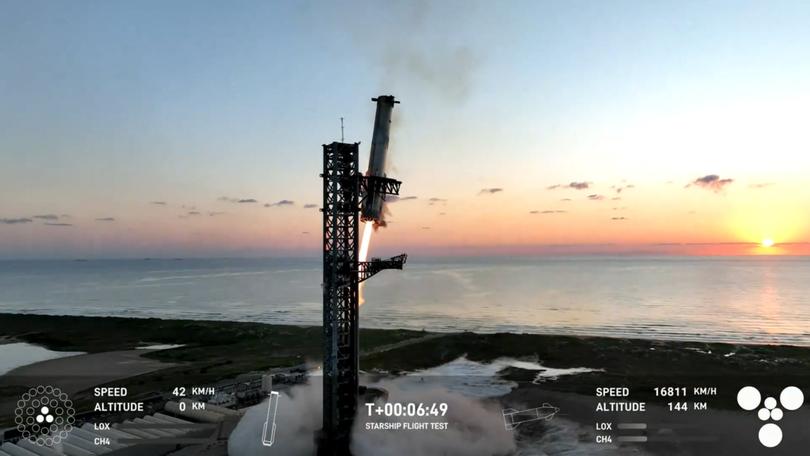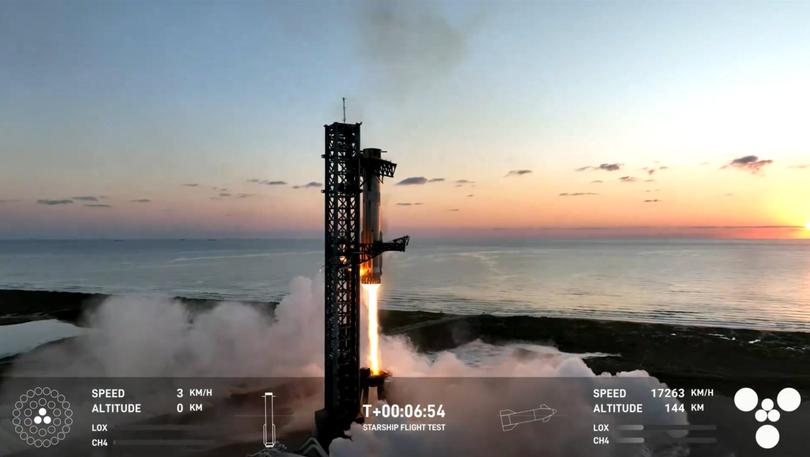THE ECONOMIST: Elon Musk’s SpaceX has achieved something extraordinary

The launch was remarkable: a booster rocket with twice the power of the Apollo programme’s Saturn V lancing into the early-morning sky on a tight, bright column of blue-tinged flame. But that wonder has been seen four times before. It was the landing of the booster stage of SpaceX’s fifth Starship test flight which was truly extraordinary.
Just a kilometre or so above the surface of the Earth, having fallen back from the edge of space, and still travelling at roughly the speed of sound, the 71m-long steel cylinder, bigger than the fuselage of a Boeing 747, relit 13 of its 33 engines. Seconds later, having cut its speed to a couple of hundred kilometres per hour, it turned most of them off, leaving it balanced on the thrust of just three engines like a broom handle on a finger.
Those engines guided it to the 146-metre-tall gantry tower from which, just seven minutes earlier, it had taken off. As the booster slid down past the tower, still at what seemed a slightly worrying angle, the tower’s massive arms closed on it. And so it came to rest, hanging high in the Texas sky, sporadic flames still licking around its base: stranded, a little ungainly and incredible in almost every sense of the word.
Sign up to The Nightly's newsletters.
Get the first look at the digital newspaper, curated daily stories and breaking headlines delivered to your inbox.
By continuing you agree to our Terms and Privacy Policy.The landing was a triumph for the engineers of SpaceX, a company founded and run by Elon Musk. It strongly suggests that the company’s plans to use a huge reusable booster to launch a huge reusable spacecraft, the Starship proper, on a regular basis are achievable. That means that the amount of cargo that SpaceX can put into orbit for itself and its customers, including the American government, is set to grow spectacularly in the second half of this decade.
And the cost per tonne of putting that stuff up there should be reduced dramatically. According to an estimate by Citigroup, a bank, SpaceX’s semi-reusable and frequently flown Falcon 9s have already brought down the price of launch by a factor of ten. A much bigger and fully reusable Starship should do at least as much again and possibly much more. It is potentially the biggest leap forward in spaceflight seen since the 1960s.
Further proof that such operations are a comparatively near-term possibility was provided when, an hour after the Super Heavy returned to the pad in Texas, the Starship itself splashed down softly into the Indian Ocean. Unlike Super Heavy, the Starship has to re-enter the Earth’s atmosphere at orbital velocities of over 26,000km/h.
On this test flight the heat shielding needed to cope with that re-entry worked much better than it had on the previous test flight in June, but was still not perfect. Live video clearly showed some of the craft’s structure burning through, eliciting a groan of concern from the assembled SpaceX employees watching. That said, the Starship seemed to go through its landing manoeuvres just as planned, and to splash down in the site intended – its return captured by a camera on a buoy put there for that purpose.
The flight showed how far ahead of any competition SpaceX now is. The engineers working on Starship were able to get their booster back to Earth because they have a lot of experience returning the much smaller first stages of the Falcon 9. SpaceX has been landing those first stages – which have their own landing legs and thus do not need catching in mid air – since the end of 2015, and has now done so over 300 times.
No other rocket company currently has a reusable first stage at all, though two of them seem close. Blue Origin, owned by Jeff Bezos, the founder of Amazon intends to test such a rocket in the next few months and RocketLab, a smaller startup, plans to get one launched next year; various Chinese companies are working on the technology too.

There are more tests to come. SpaceX needs to show that the Starship can turn its engines on and off in space, and thus get into a proper orbit and get out of one. Eventually it needs to show that it can land the Starship, too, in the arms of a gantry. But SpaceX is happy to run test flights a lot more frequently than most rocket companies; having done two in 2023, this was the third in 2024, and the pace will almost certainly quicken. This flight’s success strongly suggests that, though there are almost certainly some failures ahead, the company should have at least an initial operational capacity in as little as a couple of years’ time.
Once that happens there will be plenty of work for it to do. NASA’s Artemis programme of crewed human landings is completely dependent on Starships being able to reach orbit regularly—at least once a week, maybe more. The company’s own plans to increase both the number and size of the satellites in its Starlink communications system — a number which already sits at over 6,000 — also depend on Starship. And then there is Mr Musk’s dream of settling Mars. He is talking of sending five uncrewed Starships there in 2026, and crewed ones fairly soon thereafter.
Mr Musk’s ambitions for Mars are part of an ambition to safeguard civilisation which also entails, in his eyes, the re-election of Donald Trump (on which he is working hard), and, apparently, the use of X, a social network he owns, as a personal platform and a tool for the spread of misinformation. This is something about which many have strong concerns, and rightly. But with the Super Heavy cooling down in its elevated cradle, the getting to Mars bit, at least, looks more real than it has ever done before.
